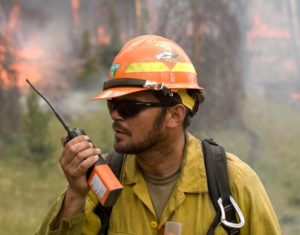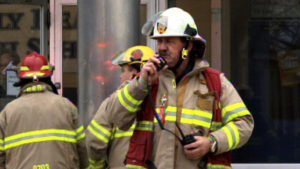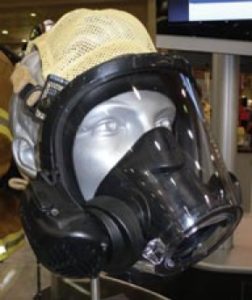By Robert Avsec, Executive Fire Officer
The portable radio is the single-most versatile piece of equipment that a firefighter or officer  can carry into a hazardous situation.
can carry into a hazardous situation.
Why do I believe that? Because portable radios are the primary means for:
- All responders to begin becoming informed and educated about the incident once the first firefighter or officer arrives on the scene;
- The incident commander to execute command and control activities;
- Officers and firefighters deployed to tactical assignments in the hazard area to communicate their observations and progress to the IC and to receive updated orders; and
- Personnel in the hazard area back to talk to the IC should there be a Mayday event.
For all of the above types of communication to work, however, it is imperative that all portable radios on the scene are in good working order and that all personnel are skilled and practiced in their operation.
1. Know your hardware
Your life may one day depend upon knowing which button or knob on your portable radio to use — and you might only have one chance to get it right. Using the incredible capabilities of today’s portable radios is a critical skill, and like any other skill, if you don’t use it, you lose it.
Practice often using your radio’s different features while wearing firefighting gloves, especially with those features that you don’t routinely use. If that day comes when you really need a particular feature of your radio, chances are you’ll be in a firefight, so prepare.
Remember Murphy’s Law. If something can go wrong, it will go wrong and usually at the most inopportune time. Carefully review and practice troubleshooting guidance provided by the manufacturer. Your ability to work through a radio malfunction on scene may be critical to your safety and that of others.
inopportune time. Carefully review and practice troubleshooting guidance provided by the manufacturer. Your ability to work through a radio malfunction on scene may be critical to your safety and that of others.
2. Pay Attention to Your Radio’s Position
The optimal position for a portable radio transmission is at head height with the antenna in a vertical position. Not exactly the position you may find yourself when involved in fire combat operations, right?
Place your radio in the radio pocket of your turnout coat while you’re crawling along the floor and this is what you have. What’s the problem? The radio’s antenna is far from its optimal transmitting position and some of the transmitted energy is absorbed by your body.
The result is a poor radiation pattern and a reduction in range of the radio. One solution is to move to a position where you can sit up and get the radio closer to its optimal transmitting position.
Many users do not use a radio pocket or radio case. While this certainly puts the radio in a slightly better transmitting position, it also exposes the radio to heat, smoke, water and particulates. Left unprotected, the radio may fail to operate when you most need it.
Radio cases with shoulder straps provide little protection and are an entanglement hazard when worn on the exterior of turnouts.
See Related: How Firefighters Should Carry Their Portable Radio
3. Use Good Radio Practices
Learn and master the following components of radio communication under non-stressful  conditions. Doing so will greatly enhance your portable radio communication, especially when the heat is on.
conditions. Doing so will greatly enhance your portable radio communication, especially when the heat is on.
- Before speaking, formulate what information is being communicated and put the information in a standardized reporting template. If your organization has a standardized format for radio communications, learn it and use it consistently. An example of such a format is: [Who are you calling?] “Command [Who are you?] from Engine 26. [Where are you?] My crew is on stairwell, advancing to second floor with attack line. [CPR (conditions, progress and resources)]. Heavy heat and smoke conditions. Holding our position. Need ventilation of second floor before we can continue.”
- Often, ICs are overwhelmed by excess information on the radio. This is where consistent use of a standard radio-reporting format will help determine if information needs to be transmitted. Develop your radio discipline by asking yourself: Has anything changed from my last CPR report? If face-to-face communication is possible between members of a crew and the information is not needed by the IC, don’t get on the radio.
- Emergency scenes are heavy with noise pollution from running apparatus and portable power equipment like saws, ventilation fans, etc. Your radio might also be exposed to rain, snow or water from firefighting operations.
Minimize microphone exposure by practicing shield, move and talk — shield the microphone using your hand, the bill of your helmet or your turnout coat; move away from the source of exposure, even if you can only turn your back to the source; talk directly into the microphone as much as possible, and keep the microphone 1 to 2 inches away from your mouth. If you do not have a speaking diaphragm or voice port on your facepiece, position the microphone against your lower jawbone on the skirt of the facepiece.
- When speaking into a microphone use a loud, clear and controlled voice — avoid shouting. When excited, our speech is often both louder and faster. When this happens, our radio transmissions can be unintelligible and may require the IC to ask for a rebroadcast, and thus more radio traffic on the channel. If your intended receiver is consistently asking you to repeat radio communication, you probably need to work on this.
These skills can improve your radio transmissions quality, but what about the communication that comes your way? All of that noise pollution can certainly diminish your ability to hear the information that others are trying to get to you via your radio.
4. Use Hearing Protection
The introduction of the remote microphone for portable radios, or collar mic, has greatly helped to overcome this challenge, but we lose that advantage when we don’t keep the remote mic in close proximity to our ear.
Another useful adjunct is a set of foam earplugs; these can reduce the level of high-frequency noise from engines, power saws, operating hose lines, etc., and enable radio communications to be more clearly understood.
I found this to be true as a command officer. After I’d declared the incident under control, I would leave the noise-controlled environment of my command vehicle to do some managing by walking around. My earplugs enabled me to clearly hear all radio traffic coming over my remote mic that was clipped to the collar of my turnout coat.
Yet, technical issues can arise. You need to recognize technical problems and take corrective action to improve communications. Do not tolerate an inoperable radio when you are in the hazard area. If you cannot communicate with the incident commander, it’s an accountability and safety issue. Get it fixed or get out.
Good radio communications are critical for safe, efficient and effective operations on the emergency scene. How many times has poor incident communications been cited as a significant factor in NIOSH investigations of firefighter fatalities on the fireground?
Follow the advice I’ve provided here and I firmly believe that you’ll have taken significant steps to minimize poor communication, and in turn, set up you and your team for fireground success.
 Fire & EMS Leader Pro The job of old firefighters is to teach young firefighters how to become old firefighters!
Fire & EMS Leader Pro The job of old firefighters is to teach young firefighters how to become old firefighters!